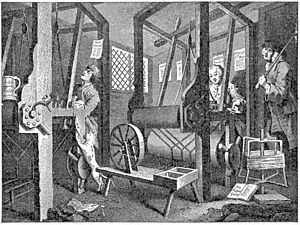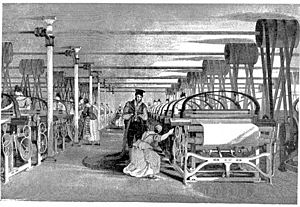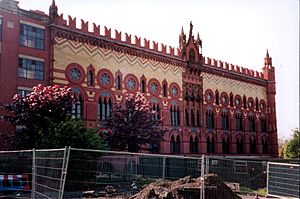Calton weavers facts for kids
The Calton weavers were a group of people who made cloth by hand in a village called Calton. This village was in Lanarkshire, just outside Glasgow, Scotland, during the 1700s. In 1787, these weavers went on strike because they wanted better pay. Sadly, soldiers shot at the people protesting, and six weavers died. Later, in the early 1800s, many weavers moved to Canada. They settled in places like Carleton Place and other towns in eastern Ontario, where they kept working as weavers.
Contents
Where Did the Calton Weavers Come From?

In 1705, a man named Walkinshaw bought some land near Glasgow. He wanted to create a village for weavers there. This land was first called Blackfauld.
Walkinshaw faced problems after a rebellion in 1715, which left him broke. So, in 1723, the Glasgow Town Council bought the land back. They named it Calton. In 1730, Glasgow sold Calton to the Orr family, but the name stayed the same.
Calton was located on the east side of the River Clyde, just upstream from Glasgow. Even though it was close to Glasgow, Calton was its own village. It became a separate town (a municipal burgh) and didn't officially join Glasgow until 1846.
The new weaving village of Calton was outside the control of Glasgow's weaving guild. Guilds were groups that controlled trades and set rules. On February 23, 1725, the weavers of Glasgow and Calton made an agreement. This agreement helped control the weaving industry. It made sure that the quality of cloth was good. It also stopped unfair competition between the two groups.
This agreement involved payments. Even as late as 1830, Calton weavers paid the Glasgow weavers a small fee for each loom they used. They also paid a yearly amount of money.
Weaving technology got better throughout the 1700s. It was still easy for a master weaver to work from home. The quality of linen cloth became more even. Weavers could also make more cloth faster. There was a steady demand for cloth from British colonies in North America and the Caribbean. These colonies were protected from competition from other European countries.
Calton was most successful after 1780. This was when the flying shuttle was introduced. The flying shuttle was a new tool that made weaving much faster. At this time, weavers' wages rose to almost £100 a year. Weavers became important members of society.
The handweavers of Calton were known for their clubs. These were like friendly societies. The Calton book club helped weavers learn and get an education. This showed that skilled workers wanted to improve their lives. Other clubs focused on things like wages and working conditions. These groups later became early versions of trade unions.
The Calton community seemed to be managed better than nearby Glasgow. In 1840, a study noted that Calton was cleaner and more organized. Its leaders made sure that all lodging houses had licenses. They also enforced strict rules about cleanliness. The streets had good sewers that were kept very clean.
How Did the Industrial Revolution Change Weaving?
Between 1760 and 1830, many people were forced to leave their farms. This was due to changes in farming called the Lowland Clearances. Families had to move to cities to find work, often in factories. Life was very hard. Many people faced poverty, sickness, and despair.
These displaced farm workers had few skills other than weaving. They crowded into the mills, which caused wages to drop. The end of the Napoleonic wars in 1815 also added more soldiers to the workforce. This made the problem worse.
Many Irish immigrants also came to Glasgow, increasing the working population. By 1851, about 23% of Glasgow's population was from Ireland. Some people blamed the Irish for crime and unemployment. However, records from that time showed that Irish immigrants were often more willing to work. They were also less likely to ask for help than Scottish people.
From the late 1700s, and even more in the 1800s, the weaving industry became more mechanized. This means machines started doing more of the work. The flying shuttle cut the time needed to weave a piece of cloth in half. Although it was invented earlier, it only came to Scotland at the end of the 1700s.
Steam-powered spinning mills began to be built in 1798. Power looms, which were machines that wove cloth using power, were used in Scottish linen weaving as early as 1810. The growth of the population and the rise of machines led to many social problems.
Social Problems and Challenges
The Calton Weavers Strike
In the summer of 1787, the journeymen weavers of Calton started asking for higher wages. A journeyman was a skilled worker who had finished an apprenticeship. The dispute became very serious. Strikers cut cloth from the looms of weavers who kept working for the old low pay. They also made bonfires in the streets using goods from warehouses.
On September 3, the city leaders and police went to Calton. But the crowd pushed them back. Soldiers from the 39th Regiment arrived, and a battle happened in Duke Street. The Riot Act was read, which meant the crowd had to leave or face force. Then, soldiers fired their muskets. Three weavers were killed, and others were hurt. The soldiers quickly stopped any more trouble. This was the first major industrial dispute in Scotland's history. The Calton Weavers became known as Scotland's first working-class martyrs. A martyr is someone who dies for a cause.
Life in the 1800s
In October 1800, there were riots in Calton because people didn't have enough food. In 1816, a soup kitchen was opened in Calton. This led to another riot that soldiers had to stop. By the 1830s, the Calton handloom weavers were among the poorest skilled workers. Not just men, but women and children also worked the looms to survive. During the frequent economic downturns of that time, many had to sell their blankets and clothes to avoid starving.
Power loom factories were a big threat to handweavers. In 1816, two thousand rioters tried to destroy these factories in Calton. They also threw stones at the factory workers.
An investigation into wages in 1812 found that rules set in 1792 about weavers' pay were not being followed. Wages had dropped a lot. For six days of work, a weaver used to earn 18 shillings, but now only earned 8 shillings.
In 1834, another investigation found that everyone had work, but because there were so many workers, everyone was very poor. The average workday was about 13 hours. Workers earned about 6 shillings and 5 pence for a six-day week. From this, 1 shilling and 5 pence was taken out for renting the loom.
Even though women had worked as weavers for a long time, male journeymen weavers saw women as competition. In 1810, the Calton weavers' group decided that no new female apprentices could be taken on. The only exception was if they were from a weaver's own family. In June 1833, male cotton spinners went on strike against female spinners at a mill in Calton. They used violence to force the women out of their jobs.
Children often worked in the mills. The owner of a factory in New Lanark said that when he bought his mill, he found 500 children working there. Most were between five and eight years old. They had been taken from poor-houses. Even though these children were fed and clothed, their growth was often stunted. Another mill owner said that most of the children he hired, who were under ten, had very poor parents. If they lost their jobs, it would cause great hardship for their families.
A Factories Inquiry Commission in 1833 found that children working in the mills were often too tired to eat. When woken in the morning, they couldn't even dress themselves. Scotland was considered one of the worst areas for child cruelty. The children's tiredness often led to serious accidents with the machinery.
A writer in the 1840s noted that the weavers' religious, moral, and intellectual lives used to be very good. However, as poverty stopped many from going to church or educating their children, their character was getting worse. The writer worried that their children would be in an even worse situation.
A report about Calton, given by a local leader to the British Association, described high levels of stealing. This included a system called bowl weft. Weavers and winders would secretly take cotton yarns and silks. They would sell these to small manufacturers to earn extra money. This was estimated to be about one penny per day for each man.
When Calton officially became part of Glasgow in 1846, its history became part of Glasgow's. The city grew even more. Textile mills, clothing factories, and dye works got bigger. Carpet-making and leather works also expanded. New shipping lines on the deepened River Clyde made exporting goods much easier. Glasgow also started to focus on heavy industries. These included shipbuilding, making locomotives, and other engineering. These industries could use the nearby supplies of coal and iron ore.
Moving to New Lands
The Scottish weaver communities formed many groups to help people move away. They asked the government for help. They received some help with their journey and free land in the Rideau Valley. This was an important area in Upper Canada (now Ontario). The government wanted loyal Scottish people to settle there.
Nearly three thousand people were helped to move in 1820 and 1821. They founded the Lanark Settlements in what is now Lanark County, north of Perth, Ontario. You can find many Scottish place names in this area. These include Perth, Glengarry, Lanark, and Renfrew. These places are along the Rideau Canal and in the small lake area north of Kingston. Most of the first settlers came from the crowded towns and countryside of Lanarkshire and Glasgow. Many of them found work in the new woolen mills that opened in the area.
See also



